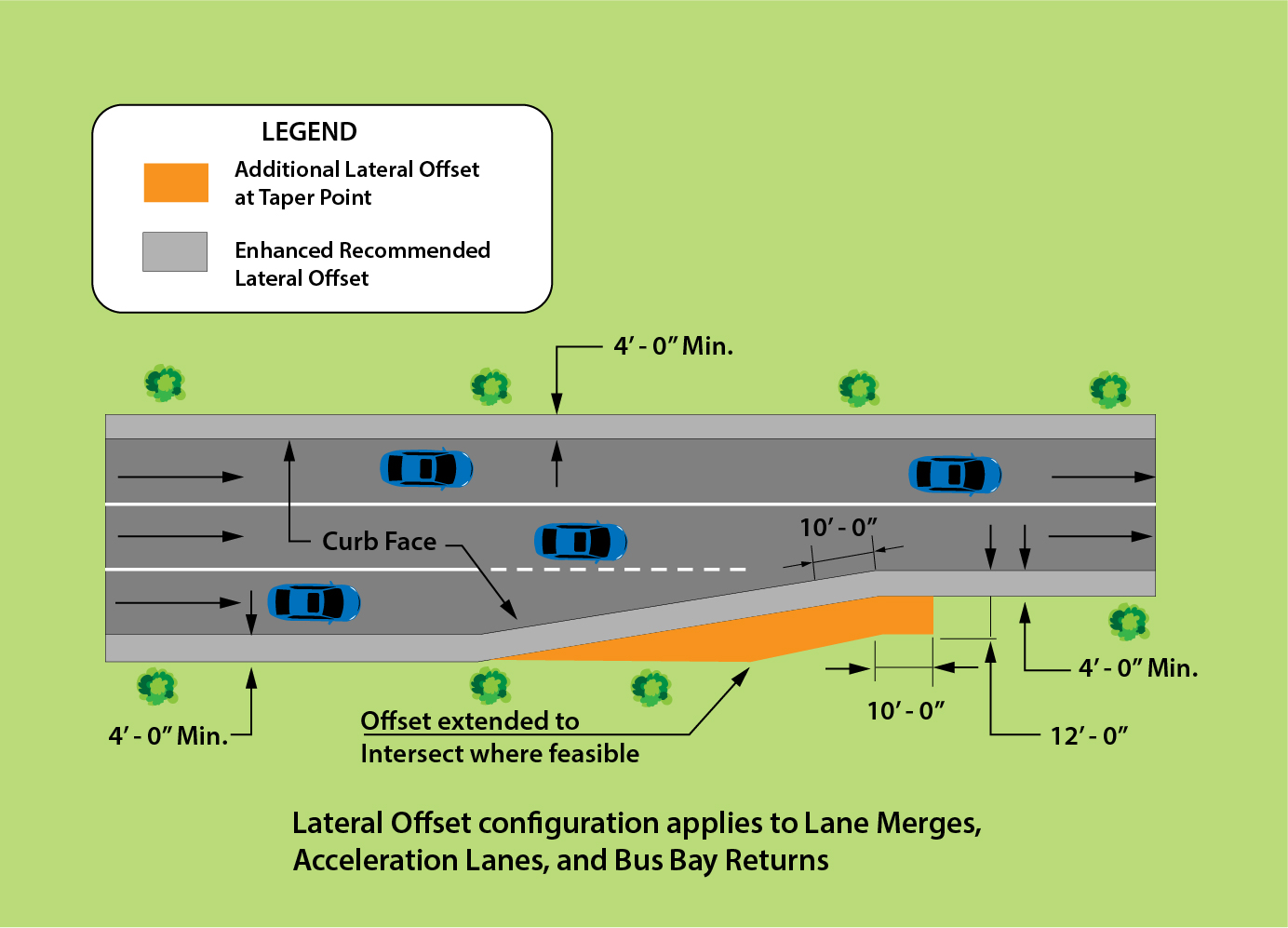Search for articles or browse our knowledge portal by topic.
Enhanced Lateral Offsets in Urban Environments
Chapter 10 of the RDG discusses clear zones in low-speed, urban areas. Clear zone values listed in Table 2-1 in the Clear Zone Overview article are appropriate for freeways and other controlled access facilities in urban areas. But these values are not always practical for other types of urban facilities, where there are likely to be limitations when establishing a clear zone. Urban roadways also usually operate at lower speeds which are not addressed by Table 2-1 in the Clear Zone Overview article. In transition areas, select operational and safety treatments based on their unique operating characteristics.
In urban areas where establishing clear zone distances listed in Table 2-1 in the Clear Zone Overview article is not feasible, rigid objects must still be located as far away from the active traveled way as possible. More than 80% of urban roadside crashes have a lateral offset ≤ 4 ft from the face of curb and more than 90% have a lateral offset < 6 ft. Table 2-1 lists recommended enhanced lateral offset values that can be used in lieu of clear zone values for urban roadways:
| Table 2-1: Enhanced Lateral Offset Values for Urban Roadways | ||
| Location (urban) | With Vertical Curb1 | Without Vertical Curb2 |
| Outside-of-Curve | 6 ft | 12 ft |
| Other Locations (not outside-of-curve) | 4 ft | 8 ft |
Table 2-1: Table Key
1 Measured from face of curb
2 Measured from edge of through traveled way
Also, consider sight distance requirements on the inside of the curve.
Figure 2-1: Enhanced Lateral Offset

Ideally, appurtenances should be located as far away from the traveled way as practical. Maintaining at least 4 ft from the face of curb can minimize the probability of being hit by an errant vehicle. Use breakaway designs for poles and appurtenances located < 6 ft from the curb’s face. Figure 2-2 illustrates light poles and signs with breakaway supports that are typically located near the road in urban areas, and Figure 2-3 shows an enhanced lateral offset to trees along a suburban roadside.
Figure 2-2: Breakaway Supports

Figure 2-3: Image of Enhanced Lateral Offset

Lateral offsets at merge points (e.g., terminations of accelerations lanes, lane drops) are also recommended to reduce crashes at these locations. Figure 2-4 provides offset distances. Consider using a 10–15 ft enhanced lateral offset near driveways.
Figure 2-4: Enhanced Lateral Offset at Merge Points

- HD-800 Roadside Design
- HD 1201.4 Sign Supports
KYTC Design Executive Summary (DES) Form
- 03.03 Equipment and Traffic Control Devices Not In Use.
KYTC Construction (CST) Manual
- CST 1315 Inspecting Sign Installation
- CST 1317 Signalization
KYTC Traffic Operations (TO) Manual
- TO-609-1 Operational Design – Physical Design (Hardware)
- TO-705 Lighting – Plan Development
- TO-710 Lighting – Intersection Delineation Lighting
KYTC Utilities and Rails (UR) Manual
- UR-401-2 General Utility Accommodations Practices – Design Considerations
- UR-401-4 General Utility Accommodation Practices – Overhead Facility Design
- UR-402-3 Utility Installations on Fully Controlled Access Highways – Overhead Utility Crossings
- PE-204 General – Work Zone Safety
- PE-301 Utilities – Overview
- PE 302 Utilities – Installations on Fully Controlled Access Highways
- PE 1101 Welcome Signs – Overview
- PE-1201 Fairs, Parades, Festivals, & Banners – Overview
- PE-1301 Garbage Containers – Overview
- PE-2001 Landscaping – Overview
AASHTO. Roadside Design Guide, Fourth Edition, RSDG-4. American Association of State Highway and Transportation Officials, Washington, DC, 2011.
AASHTO. Guidelines for Geometric Design of Low-Volume Roads, Second Edition. American Association of State Highway and Transportation Officials, Washington, DC, 2019.
Roadside Safety Clear Zone Concepts Knowledge Book:
Access the complete Knowledge Book here: Roadside Safety Knowledge Book and Clear Zone Concepts Knowledge Book
Next Article: Clear Zone in Work Zones
Previous Article: Clear Zone and Roadside Drainage Features

